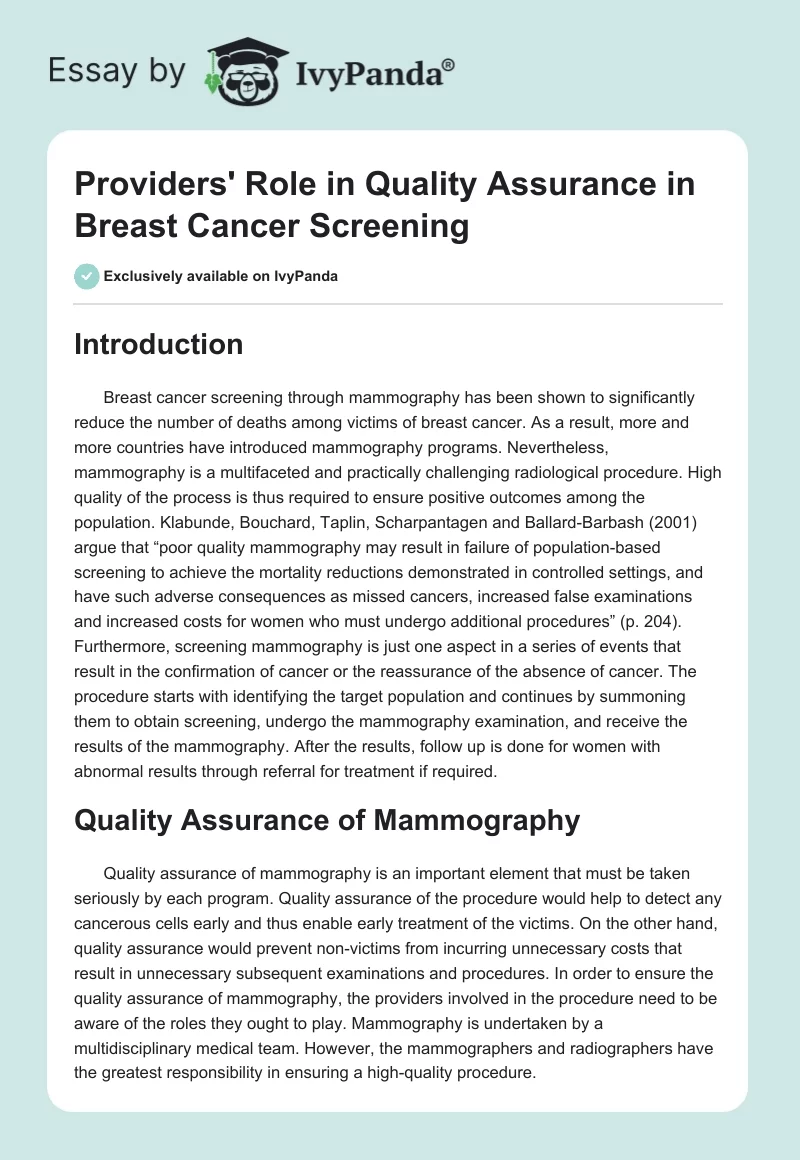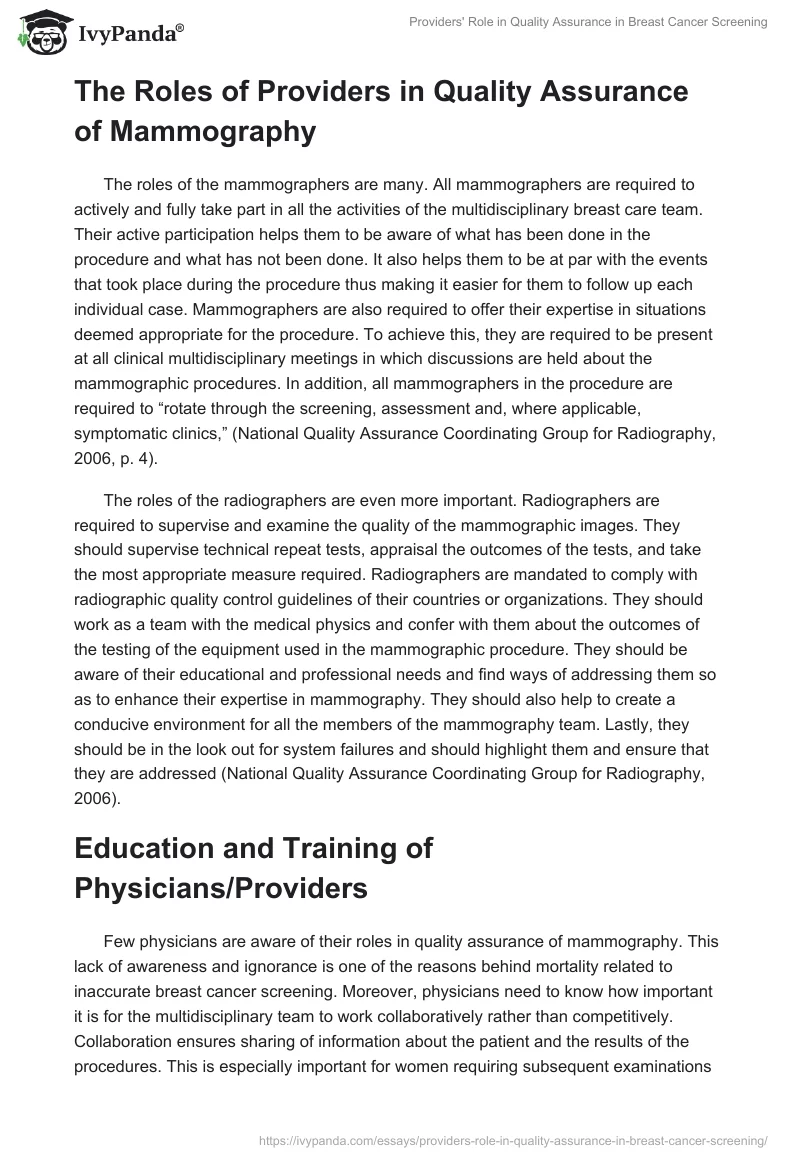Introduction
Breast cancer screening through mammography has been shown to significantly reduce the number of deaths among victims of breast cancer. As a result, more and more countries have introduced mammography programs. Nevertheless, mammography is a multifaceted and practically challenging radiological procedure. High quality of the process is thus required to ensure positive outcomes among the population. Klabunde, Bouchard, Taplin, Scharpantagen and Ballard-Barbash (2001) argue that “poor quality mammography may result in failure of population-based screening to achieve the mortality reductions demonstrated in controlled settings, and have such adverse consequences as missed cancers, increased false examinations and increased costs for women who must undergo additional procedures” (p. 204). Furthermore, screening mammography is just one aspect in a series of events that result in the confirmation of cancer or the reassurance of the absence of cancer. The procedure starts with identifying the target population and continues by summoning them to obtain screening, undergo the mammography examination, and receive the results of the mammography. After the results, follow up is done for women with abnormal results through referral for treatment if required.
Quality Assurance of Mammography
Quality assurance of mammography is an important element that must be taken seriously by each program. Quality assurance of the procedure would help to detect any cancerous cells early and thus enable early treatment of the victims. On the other hand, quality assurance would prevent non-victims from incurring unnecessary costs that result in unnecessary subsequent examinations and procedures. In order to ensure the quality assurance of mammography, the providers involved in the procedure need to be aware of the roles they ought to play. Mammography is undertaken by a multidisciplinary medical team. However, the mammographers and radiographers have the greatest responsibility in ensuring a high-quality procedure.
The Roles of Providers in Quality Assurance of Mammography
The roles of the mammographers are many. All mammographers are required to actively and fully take part in all the activities of the multidisciplinary breast care team. Their active participation helps them to be aware of what has been done in the procedure and what has not been done. It also helps them to be at par with the events that took place during the procedure thus making it easier for them to follow up each individual case. Mammographers are also required to offer their expertise in situations deemed appropriate for the procedure. To achieve this, they are required to be present at all clinical multidisciplinary meetings in which discussions are held about the mammographic procedures. In addition, all mammographers in the procedure are required to “rotate through the screening, assessment and, where applicable, symptomatic clinics,” (National Quality Assurance Coordinating Group for Radiography, 2006, p. 4).
The roles of the radiographers are even more important. Radiographers are required to supervise and examine the quality of the mammographic images. They should supervise technical repeat tests, appraisal the outcomes of the tests, and take the most appropriate measure required. Radiographers are mandated to comply with radiographic quality control guidelines of their countries or organizations. They should work as a team with the medical physics and confer with them about the outcomes of the testing of the equipment used in the mammographic procedure. They should be aware of their educational and professional needs and find ways of addressing them so as to enhance their expertise in mammography. They should also help to create a conducive environment for all the members of the mammography team. Lastly, they should be in the look out for system failures and should highlight them and ensure that they are addressed (National Quality Assurance Coordinating Group for Radiography, 2006).
Education and Training of Physicians/Providers
Few physicians are aware of their roles in quality assurance of mammography. This lack of awareness and ignorance is one of the reasons behind mortality related to inaccurate breast cancer screening. Moreover, physicians need to know how important it is for the multidisciplinary team to work collaboratively rather than competitively. Collaboration ensures sharing of information about the patient and the results of the procedures. This is especially important for women requiring subsequent examinations and treatment. In order to increase awareness in mammographic quality assurance, physicians/providers are engaged in education and training programs (Katalinic, Bartel, Raspe & Schreer, 2007).
Various educational opportunities are available for mammographers. Engagement in further education enables the mammographers to generate high quality mammographic images at all times and to be an active participant in the medical team in charge of the breast screening. However, the education programs in which the mammographers enroll must be approved by the national body in charge of authorizing such programs. The education program can be based in a higher learning institution as part of a postgraduate program. Besides further education, the providers should be trained on a regular basis on quality assurance of mammography. There are various training centers available across the country that train mammographers. In addition, healthcare organizations hold training sessions for mammographers to ensure that the procedure undertaken by the medical is of high quality. Training enhances the professional development of the providers by instilling in them critical skills and proficiency. Most importantly, training enables the providers to work as a team which is important in quality breast cancer screening (National Quality Assurance Coordinating Group for Radiography, 2006).
What Works and What Does Not
In quality assurance of mammography, there are some important aspects that should be taken into consideration. The first is the expertise of the mammographers and radiographers. The expertise of these professionals determines their ability to accurately carry out the procedure and detect any abnormal cells in the women’s breasts. Secondly, the equipment used in the procedure is very critical. It is the responsibility of the breast cancer screening team to ensure that all equipment used is tested before use. The testing and its results should be discussed in depth between those in charge of the testing and those in charge of using the equipment. Quality assurance in mammography cannot be achieved without high quality equipment even if the professionals are highly proficient. High quality equipments produce high quality images which facilitate accurate diagnosis of breast cancer. Lastly, teamwork is of necessity in quality assurance of mammography. Team work entails each professional playing his/her role at level best, but working collaboratively with other members of the team. Team work is especially important in information sharing which is in turn critical in accurate diagnosis and treatment of the cancer. Without these three aspects, quality breast cancer screening cannot be achieved (Katalinic et al., 2007).
Recommendation for Further Improvements
Much of what has been discussed in this paper focuses on outcomes of breast cancer screening as influenced by the process. However, it is important to note that process and outcome cannot exist in isolation with the structure of the organization. In order to ensure quality assurance of mammography, it is thus important to enhance the quality of the organization offering the mammographic services. Process improvement entails “improving the staffing patterns, programs, finances, facilities and the system design,” (Martin, 1996, p. 89).
Reference List
Katalinic, A., Bartel, C., Raspe, H., & Schreer, I. (2007). Beyond mammography screening: quality assurance in breast cancer diagnosis (The QuaMaDi Project). British Journal of Cancer, 96, 151-161.
Klabunde, C., Bouchard, F., Taplin, S., Scharpantagen, A., & Ballard-Barbash, R. (2001). Quality assurance for screening mammography: An international comparison. Journal of Epidemiology and Community Health, 55(3), 204-212.
Martin, E. E. (1996). Community health centers and quality of care: A goal to provide effective health care to the community. Journal of Community Health Nursing, 13(2), 83-92.
National Quality Assurance Coordinating Group for Radiography. (2006). Quality assurance guidelines for mammography including radiographic quality control. Sheffield: NHS Cancer Screening Programs.


